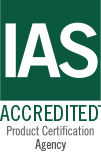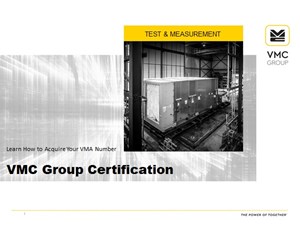Preapproval
Preapproval of Special Seismic and Wind Certification by VMC Group's Test and Measurement Division, is a Seismic Qualification Program for equipment manufacturers. Products that successfully complete this preapproval process will receive a Special Seismic or Wind Certification VMA Number as a 'Certificate of Compliance' that the Designated Seismic System shall maintain structural integrity and functionality after a Design Earthquake.
FAQs
-
How must testing be carried out for units with different structural configurations?
If the units are to be qualified for different support, mounting, or attachment conditions with and without vibration isolators (internal and external isolators are NOT equivalent) and different mounting types, such as wall mounted vs. floor mounted, etc., testing is required for the "worst-case" of each installation configuration.
OR
Two units must be tested for each anchorage or mounting configuration.
-
How must testing be carried out for units made from different materials?
If the units are made of different materials (e.g. carbon steel vs. stainless steel), the Unit Under Test (UUT) containing the material providing the least seismic capacity shall be selected. (Alternate materials may be certified by comparison rationale.)
OR
Two units must be tested for each material.
At least one test is required for non-active components or structures.
-
How must testing be carried out for units with different sub-component manufacturers?
If sub-components are made by different manufacturers, a shake table test for each manufacturer is required for active components. The UUT selected as a representative sample should have the least seismic capacity (ICC-ES AC156 4.5.1).
OR
Two units must be tested for each manufacturer.
Special Seismic Certification pre-approval is valid for components with design, construction and quality control equivalent to the units tested.
-
Is simultaneous testing of multiple units on the shake table permitted?
Yes. Multiple units can be tested on the shake table simultaneously provided the table is capable of achieving the Required Response Spectra (RRS) with the total payload.
-
What are the test facility requirements?
Testing laboratories shall have ISO-17025 accreditation.
OR
Testing shall be under the responsible charge of an independent licensed engineer.
-
What are the test report requirements?
Test reports shall be reviewed and accepted by an independent, licensed structural engineer, unless prepared by one.
-
Are there any meetings that need to take place during this process?
VMC Group strongly recommends an engineering review and in-person meeting with the manufacturer’s design team to define the following:
- Tailored Project Plan
- Project Path
- Seismic Design Level
- Product Scope
- Analysis Scope
- Shake Table Testing Scope
- Mounting/Attachment Scope
- Roles, Responsibilities and Success Criteria
-
What about auditing, material changes and maintaining certification?
VMA approval is maintained based on all of the following:
- Production of the approved product design is current.
- The continued use of accepted quality assurance/procedures.
- Compliance with the terms stipulated in the approval agreement.
- Successful re-examination of production samples to ensure conformity to approval requirements.
- Satisfactory completion of engineering and quality assurance audit of the product at each manufacturing facility.
-
What conditions nullify a VMA number?
VMA approval is deemed nullified or invalid if any of the following occurs:
- Design, construction or quality control/quality assurance methods are materially altered as defined in the VMA 1826.
- Strength, stiffness, size, weight, materials, support, orientation or manufacturer are changed/altered so the product attributes are no longer equivalent to what was approved in the VMA.
- Inappropriate usage of approved VMA approval certification marks
- Expiration or non-renewal of a certificate.
-
What are the VMA submittal requirements?
- Completed application with signature attached.
- $5,000 website listing fee. (per VMA#)
- Onsite or remote audit. (Travel expenses to and from each manufacturing facility to conduct audit are at an additional cost.)
- Complete test reports in electronic format that satisfy requirements of ICC-ES AC156.
- Verification of similarities for interpolated units in the form of manufacturer’s catalog and /or schematic cut sheets.
-
What are the acceptance criteria following shake table testing?
Post-test acceptance criteria for shake table testing shall be as required by ICC-ES AC156:
- Structural integrity of components, supports and attachments shall be maintained.
- Functionality of components shall be maintained equivalent to pre-shake table functionality test.
- Functionality test shall be similar to the manufacturer’s typical pre-shipment performance tests.
-
Can active mechanical and electrical equipment get a VMA number by analysis?
No. Active and energized equipment/components shall be certified exclusively on the basis of shake table testing. Plus, only connecting elements, attachments and supports can be justified by supporting analysis.
-
Can I get a VMA number by analysis or experience data?
No. A VMA number is issued based on successful testing only.
-
Can I get a VMA number by using shake test data from another organization?
Yes. Testing done by others shall be submitted for review and acceptance by VMC Group engineering department. Additional fees may apply.
-
What Rp value can be used for Special Seismic Certification?
- Rp/Ip = 1.0 for Special Seismic Certification by testing in accordance with the ICC-ES AC156.
- Rp = 1.0 & Ip = 1.5 shall be used for analysis part of the non-active component, since functionality can’t be verified by analysis.
- ASCE7 does not provide Rp and ap values for Special Seismic Certification.
- Rp and ap values in ASCE7 can be used for design of supports and attachments.
-
What test protocol should be used for shake table testing?
- ICC-ES AC156; Acceptance criteria for seismic certification by shake table testing of non-structural components (effective October 1, 2010 and editorially revised September, 2019).
- Where normal operating conditions of equipment involve variation of contents (e.g. empty and full of operating fluid, etc.) or configuration, each operating condition or configuration shall be simulated during the tests.
- If uni-axial or bi-axial tests are used for certification, a test at 45-degrees to two horizontal orthogonal directions shall be required in addition to tests in two primary horizontal and vertical directions.
-
Can a component tested with rigid and isolated supports justify installation with intermediate support conditions?
Yes, provided mounting configurations (e.g. installation is wall mounted, etc.) are similar and the only difference is in the attachments.
-
Are tests in accordance with ICC-ES AC156 by non-U.S. shake table testing facilities acceptable?
Yes, provided:
- The test facility has ISO 17025 accreditation.
- The test report is available in English.
- The test report is prepared under the responsible charge of a US licensed structural engineer.
-
What components are exempt from Special Seismic Certification for buildings?
- Equipment and components weighing not more than 20 lbs. supported directly on structures (and not mounted on other equipment or components).
- Moveable (mobile) and temporary equipment/components, which are not anchored to a structure or permanently attached to the building utility services such as electricity, gas or water.
- Pipes, ducts, conduits and cable trays, excluding in-line equipment and components.
- Underground tanks.
- Electrical motors and pumps not more than 10hp that are rigidly supported directly on a structure.
-
Does a small amount of hazardous content in a component trigger Special Seismic Certification requirements?
No. Special Seismic Certification is required for components when the maximum allowable quantity of hazardous materials per control area as specified in the IBC 2012 section 414 are exceeded.
-
Does redundant or optional equipment require Special Seismic Certification?
Yes. All active components require Special Seismic Certification even if they are considered redundant or optional. Redundancy and options are provided only because they are considered necessary/required. Optional equipment may also have an effect on the functionality of the basic equipment. Consequential damage due to failure of redundant or optional components may cause failure of essential components.
-
Can the supports and attachments for equipment with a VMA number be substituted?
Yes, provided substituted supports and attachments have:
- Similar installation configurations (e.g. support mounting, attachment, orientation, etc.).
- Equivalent strength and stiffness to those tested and approved.
- Been tested to obtain quoted seismic capacities.
-
What does a special inspector need to verify in the field for Special Seismic Certification?
Special inspectors shall verify:
- Label for conformance with the certificate of compliance.
- Label shall include the components seismic capacity.
- Anchorage or mounting for conformance with the certificate of compliance and construction documents.
- Label for conformance with the certificate of compliance.
-
Can a single product with absolutely no variation be certified by one test only?
Yes, provided:
- The manufacturing process is ISO 9001 certified.
- A single product (and not a product line with more than one product with variations) is certified.
- Variations, if any, are limited to software and color/branding.
-
What systems/components require Special Seismic Certification?
- Special Seismic Certification is required for components that are part of the Designated Seismic System in accordance with ASCE7 section 13.2.2.
- All components with an importance factor equal to 1.5 are part of the Designated Seismic System in accordance with ASCE7 section 1702.
- The component importance factor shall be in accordance with ASCE7 section 13.1.3.
-
Can we submit multiple products through a single VMA application?
No. Each VMA number is for a single family of products.
-
Will VMC Group distribute approved VMA numbers?
Yes. All approved VMAs will posted on www.ibcapproval.com.


